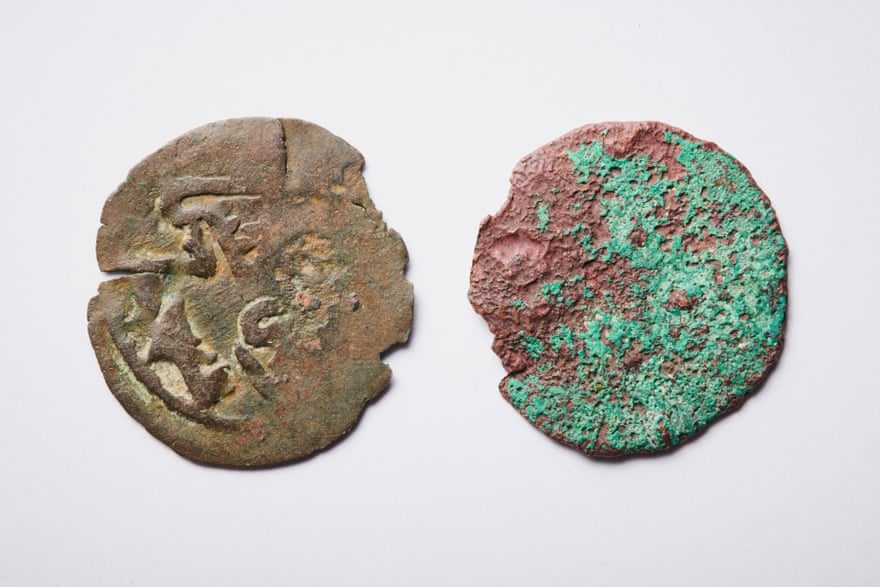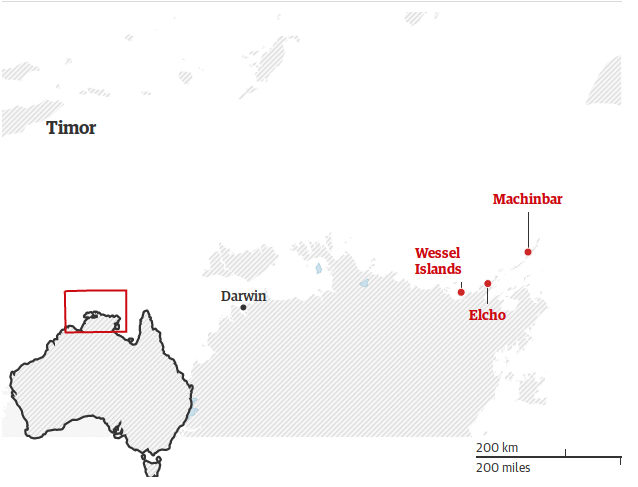
It's Anzac Day and the usually busy I-Med radiology clinic in Darwin is shiny and quiet, the public holiday giving the machines and their operators a break from the usual broken bones, brain scans and ultrasounds.
But then an archaeologist and a historian turn up, bringing with them a curious patient whose identity is unknown, but who may be 1,000 years old and could rewrite Australian history.
The "patient" is a small copper coin found by archaeologist Mike Hermes on a field trip to the Wessel Islands, off north-east Arnhem Land, last year. He believes it to be a coin from Kilwa, more than 10,000km away in what is now known as Tanzania, dating from before the 15th century. Its surface is eroded, obscuring identifying features, but Hermes is confident.

Hermes is part of the Past Masters, a group of historians, archaeologists, anthropologists, numismatists (coin experts), geochronologists and other experts who investigate historical anomalies. In the past six years they have mounted seven expeditions off the coast of northern Australia, finding previously undiscovered rock art, shipwrecks, stone tools, human remains and the Holy Grail, the Kilwa coin.
"We're looking for the earliest visitation to the coast," historian Mike Owen says.
"This has never been explored. Our history is so Sydney-centric, the identity of the nation is built around that. And Sydney is a hell of a long way away from east Arnhem Land."
Owen's office in his suburban Darwin home holds evidence of much of that little-known history. It is a treasure trove of fraying 17th century books, bits of pottery and old ammunition unearthed at local beaches, a 19th century signal gun from a shipwreck, a cannonball someone found in their Darwin backyard a few months back. Sitting atop a crocodile skull is a half-metre-long piece of wood from a Macassan prau wreck from 1895.
"I wouldn't call them treasures, they are not worth anything," he says. "At least, not commercially."
Kilwa coins
Exploring the intertidal zone at Elcho Island in July last year, Hermes didn't need his metal detector to find the small copper coin. He didn't even need to dig. It was just lying on the beach, its crusted green surface staring out at him from the sand.
But the find was no accident. The Past Masters were following in the path of Morry Isenberg, an RAAF radar operator who discovered five Kilwa coins when he was stationed briefly on nearby Marchinbar Island in 1945.
Isenberg rediscovered the coins stashed away in a matchbox tin 40 years later, and they were handed over to the Powerhouse Museum in Sydney. Although they were deemed the "earliest dated coins so far discovered in Australia" and thought to "represent an entirely new concept in early Australian history", Hermes says there has always been some lingering doubt that Isenberg's "x marks the spot might have been a bit shaky".
So the Past Masters searched nearby locations they thought were feasible, and Hermes found his coin 100 nautical miles from where Isenberg claimed to have found his.
How the coins got to this part of the world is a much more perplexing mystery.
"Kilwa coins have only been found in Kilwa, the Arabian peninsula and the Wessel Islands," Hermes says. "It's a puzzling distribution."
Owen offers a few theories. It could indicate contact between Indigenous Australians and traders from Kilwa 700 years ago. The Wessel Islands were probably not the intended destination for the coins. There was trade between Kilwa and China, and possibly those traders were blown off course or escaping from pirates. Perhaps there was a shipwreck. But he says the most likely scenario is that the Portuguese, who looted Kilwa in 1505, went on to set foot on Australian shores, bringing the coins with them.
"The Portuguese were in Timor in 1514, 1515 - to think they didn't go three more days east with the monsoon wind is ludicrous," Hermes says.
So what does the potential discovery of a coin minted 500 years before James Cook's arrival, and more than 300 years before the Dutch, mean for the pre-European history of Australia?
Numismatist Peter Lane says if this is a Kilwa coin, it adds an interesting dimension to Australia's early history.
"The value of these discoveries is very important and underrated by most people," he says. "When it comes to historical significance, how do you put a value on something like that?"
Unorthodox move
I-Med Darwin's chief radiographer, Jack Feeney, has been charged with identifying the coin - a rather unorthodox move by the Past Masters.
"You can use a special micro-CT scanner to detect the surface minutely, but there was no way we could get our hands on one of those, so this was the next best thing," Owen says.
Regional Imaging chief radiographer Jack Feeney returns after doing a CT scan on the coin.
Feeney carefully turns the thin, frail coin over in his hand, inspecting the jagged edges and pitted, uneven surface coated in grime.
"There is basically no hope for this one," he says. "I give it a 0% chance of working."
"That's what you said last time," Owen replies.
Last time was in March, when Owen first had the idea of using the CT scanner to identify another of Hermes' finds from the English Company Islands, just east of the Wessels.
The scan was able to break through the layer of green crud on the copper coin to clearly reveal the VOC (Dutch East India Company) stamp and the date: 1790.
Although there were four VOC coins in Isenberg's 1945 stash and they are not uncommon in Western Australia, this one was copper and struck in Utrecht rather than in Asia, making it the first corroborated find of a VOC coin of European manufacture in the Northern Territory.
Lane says it probably found its way there as loose change in a mariner's pocket that became caught up in and circulated with other VOC currency.
Owen believes it ended up in the English Company Islands via the Macassans, who regularly visited the area and had contact with the Dutch.
"But they were poor, how the hell did they end up with it?" he asks.
Striking similarity
Unfortunately, this time Feeney is right: after placing the ancient coin carefully on a pillow and running it through the CT scanner, only a black blob appears on his screen. Two vague ring-shapes can be seen on one edge, but these could just be divots rather than part of the coin's design.
Still, when put side by side with a Kilwa coin Owen purchased on eBay some years ago, the similarity is striking. The two coins even have the same pattern of corrosion along one edge.
The next step is to test the coin's mineralogy and match it to the make-up of confirmed Kilwa coins, which Owen says may take a few months to arrange.
Undeterred by the failed Kilwa identification, Hermes and Owen leave the lab and drive 6km to Buffalo Creek where another mystery is under way.
Dion and Jess McLean are waiting near the boat ramp with metal detectors, keen to show them the spot near the high-tide mark where they dug up a coin in February.
"In 20 years of metal detecting, it's probably the best thing I've ever found," Dion says. "Because of the potential historical value and the intrigue."
He brought the coin to Owen, and his research so far is inconclusive - the small copper coin bears what looks like Arabic script, has been plated or painted with gold, and has a small piercing on one edge. He thinks it could be a 500-year-old Iranian coin, or - due to the puncture - a trinket from a belly dancer's belt.
"I don't know who would be belly dancing at Buffalo Creek, but I rather like that theory," Owen says.
The coin's next stop is Peter Lane, the numismatist, but in the meantime, Owen and Hermes pull out their metal detectors and join the McLeans on the beach. In less than 30 minutes, the foursome dig up a piece of metal from an old army fortification, three second world war bullets, a spoon and $3.45 in change.
Hermes says the disruption to the fabric of the city caused by the war and by Cyclone Tracy in 1974, combined with large tides, means all sorts of things turn up on northern Australian shores, not all of them historically significant, and many that can be easy to miss or misidentify.
But maybe, just maybe, the coin from Elcho is a Kilwa and will change Australian history as we know it.





Comment: It wouldn't be the first discovery that threw the mainstream view of history of travel and trade into disarray: